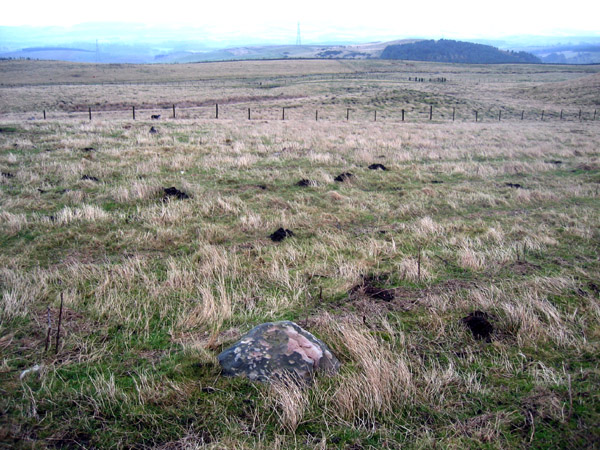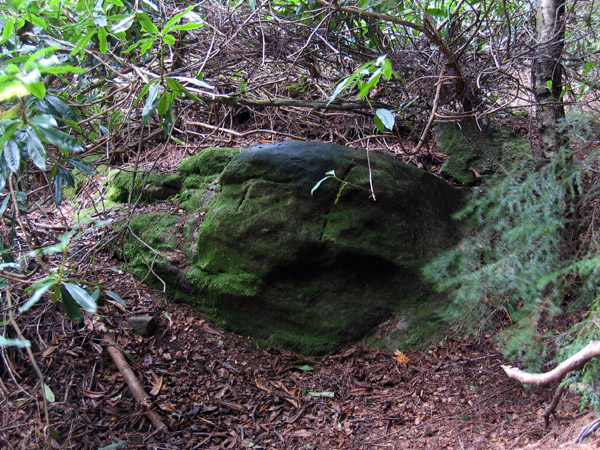
Gled Law 1; view E towards Buttony plantation (top left).

Gled Law 1; view E towards Buttony plantation (top left).


Buttony 4. Close-up of E’most motif (smaller cup with 7 concentric rings and 2 radial grooves).

Buttony 4. Close-up of W’most motif (cup with 8 concentric rings and 3 radial grooves).

View SW down Buttony outcrop from panel 6 through plantation.

Buttony 1c; 4 elements on a near vertical surface joined below by a long groove.

Buttony 1a; cup with 6 concentric rings.

View SW towards Wooler and Cheviot from just outside Buttony plantation.



Small sandstone boulder sits in the middle of a small rectangular sheep enclosure. Good views E towards Chillingham and Ross Castle.

Cup and ring marked boulder.


Rock shelter from SE, view towards Cheviot.

Motif carved on top of the dome of rock above the shelter. A large basin surrounded by a shallow groove has a long groove running south down the sloping rock surface.

Interior of rock shelter from open end. Groove pecked on floor starts at the shallow basin near to the marker.

Shallow basin and groove that follows a vein in the rock and runs down the floor of the shelter to part where Stan Beckensall excavated a cremation burial in a food vessel of c.2000 BC. Stan describes the groove as having been pecked with a hard stone tool. The basin has been roughened possibly to hold a wooden upright (other metal-cut post holes are present) and the gutter may have been originally cut as a drainage channel.

Standing stone below rock shelter; view NW towards Cheviot.

Enhanced basin surrounded by groove with a long groove running down the rock above rock shelter; view W to Edlingham old railway viaduct, village and Thrunton Wood.

Above the shelter; artificially-enhanced basin and groove.

Floor and rear wall of rock shelter. Basin in floor starts a shallow groove which runs along the vein of rock down to a lower level where a burial was found covered by a triangular rock slab.

View of Cheviot (with small rim of snow) from the rock shelter.

An almost aerial view of Edlingham from the roof of the rock shelter. A Neolithic polished stone axe was discovered here in the 1970s and is now held by the Museum of Antiquities, Newcastle.

6c(ii). View NE towards Wellhope.

6c(ii). Surface above ‘the steps’ showing the basin on the outcrop edge to the left, and eroded cup and ring motifs. View to the N.

“The Sacrificial Steps” of 6c(ii) leading to the ‘ritual basin’ and cup & ring motifs on the horizontal outcrop. View E towards Snook Bank.




View of the marked outcrop. A difficult place for photography under trees and rhododendron bushes.

Two cups connected by a straight groove. One with a single ring and the other with a double ring or penannular.


View N from the top of Caller Crag as the weak November sun sinks behind the hills.




The recorded rock art is not so convincing though.


E part of rock: deep cup and groove with enclosing penannular cut in a circular depression.

Subtle cup and ring motifs on E part of rock surface.

E part of rock surface. Motfis cut into a flat rounded basin.

Cup and partial ring on exposed W part of rock surface.

Had the chance of a later visit, better weather and a closer look at the stone surface. Close up of cups and grooves on quarried W edge of outcrop.

The cup-marked millstone (Beckensall’s 6j); view NW towards the Cheviot Hills.

Beckensall’s 6g; cups carved onto a natural rock boss.

Beckensall’s 5d; a deeply cut panel, partly turf covered.

Beckensall’s 4a; part of the main carved panel, now highly eroded and subject to water flow


?Romano-British round-house, W of Snook Bank farmhouse, view N towards the carved rock outcrops.

Beckensall 3b; position in the landscape – view to SW.